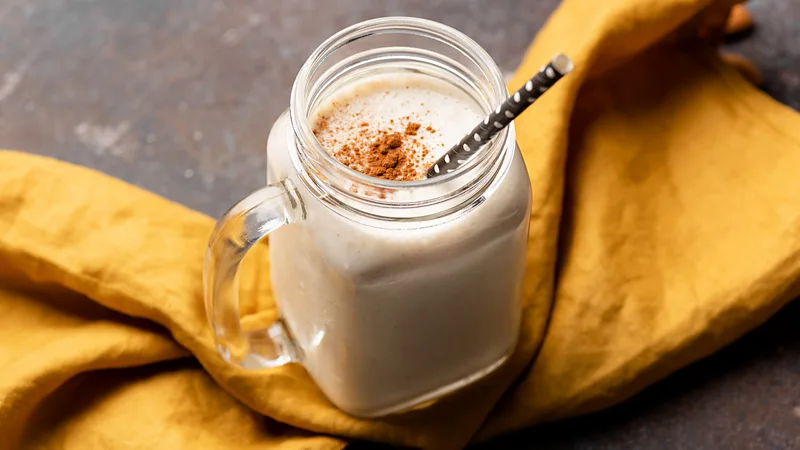Sea moss punch: The Caribbean's cooling, healthy elixir for summer
Plucked from the ocean, Trinidad's answer to the summer milkshake is now part of a frenzied craze around the world.

"I am de sea moss man. Allyuh, $10 a bag! Wat yuh want? Ah have some nice sea moss today..." intones a marchand (vendor) at a public market in Trinidad, one half of the twin island republic of Trinidad & Tobago. He holds bags filled with brownish strands of seaweed. This sea moss, the most prized seaweed in the Caribbean, will likely be transformed in local households into a delicious cooling, milky, spiced drink or punch.
Sea moss punch is enjoyed throughout the islands, at any time of the year. Vitamin-rich drinks are especially vital for replenishing the body's nutrients, especially in scorching temperatures. Used by indigenous Caribs and Arawaks for centuries as a healing elixir, sea moss is inherently bland, with a faint taste of the sea.
Sea moss must be carefully prepared. First, it is dried in the sun. "Once you dry it and store it properly, it's bound to last 10, 15, 20 years," says John Lewis, who occasionally runs tours showcasing sea moss, among other treasures, in the village of Matelot, in conjunction with The National Trust of Trinidad & Tobago.
When ready for use, the dried sea moss is soaked, boiled and cooled, allowing the agar, the natural thickening agent, locally referred to as "gel", to emerge.
Long ago, "punch men" sold sea moss punch across the islands, and, for as long as anyone can remember, dried sea moss has been readily available. "Raw, dried sea moss is sold in markets and grocery stores, packaged along with nutmeg, cinnamon and includes a recipe on the label," says Lori Lee Lum, retired community education officer at the nation's Institute of Marine Affairs. So popular is premade sea moss punch that it runs the gamut from big brands like Nestlé Supligen sold in tetra packs to bottled concentrates and pop-up smoothie shops.
"I grew up drinking it from my teenage years. There was a particular shop I would go to most Saturdays and purchase a roti and cup of sea moss," reminisces Ravi Sankar, owner of Karibbean Flavours, a producer of Caribbean-made products that sells two tonnes of sea moss monthly.
As part of a time-honoured "bush medicine" tradition, sea moss promises improvement for both sexes – aphrodisiac properties for men and increased breast milk for mothers. "For generations the benefits… have been appreciated," says Lum. "It was reputed to be good for overall health [and] digestion. The plants are high in iodine, which plays a crucial role in thyroid health and regulating metabolism."
A healthy lifestyle renaissance amongst a younger generation has now led to new beverage iterations like sea moss punch flavoured with soursop, ginger and turmeric. With its natural thickening properties, it also has multiple uses in ice cream, desserts, custards and puddings. Lewis sometimes uses the ferns to make sea moss cake, and it has even made its way into handmade soaps.
Akin to a milkshake, sea moss punch follows a straightforward recipe: blend together sea moss gel, milk, sweetener, spices and ice. The resulting flavour bears a resemblance to the richness and comfort of Christmas eggnog. The exact spices and their quantities are the real point of difference. Some prefer Angostura bitters and cinnamon. Others, like Lewis, only grated nutmeg. "Nutmeg and sea moss go hand in hand. Spice it up," he says, noting that he tends to a score of nutmeg trees just for this purpose.
The main ingredient in sea moss punch, sea moss, actually refers to a number of different species of red algae that grow throughout the region and taste similar. "While hundreds of edible seaweed species grow naturally in the Caribbean, only about 10 are harvested for food," explains Dr Farahnaz Solomon, marine biologist and research officer at the Institute of Marine Affairs. Two species in particular, Gracilaria and Eucheuma, make up the majority of sea moss across the region and are well-suited to mariculture, the farming of sea moss on long strands in the ocean. St Lucia began the practice in the 1980s, followed by Grenada and Dominica.
But the best and most prized sea moss in the Caribbean only exists in one corner of Trinidad between the north-eastern coastal villages of Toco and Matelot and all the way to Blanchisseuse. Here, a unique species of sea moss (Gelidium serrulatum) grows and must be collected by hand. "It is the only place in the Caribbean to use this type… superior to any of the varieties used as sea moss in the region," says Lum.
Gelidium serrulatum is considered the best sea moss in the region for a number of reasons. "The gel… is of better quality (thicker). The yield is also greater," clarifies Solomon.
Environmentally too, this sea moss is peculiar. It prefers more wave action and constant exposure to the elements, making it unsuitable for cultivation, says Solomon, who previously worked with the Buccoo Reef Trust attempting to develop the sea moss industry in Tobago, to no avail. Wild and unruly, growing in punishing conditions, Trinidad's one-of-a-kind sea moss can only be foraged.
Trinidad's north-east coast is a potent mix of silence and ferocity. A meandering road with rainforest at its verges slowly gives way to the small settlement of Blanchisseuse. Beach houses cling to the rugged coconut palm-rimmed shoreline that's pounded by waves, and black rocks jut into the ocean. Regularly washed away by the brute force of tropical rain, the road is, at times, impassable. It is perhaps this remoteness that has allowed sea moss to thrive.
Occasionally, jagged cliffs part to reveal sandy beaches and the waves temper, at least a little. At low tide, glistening in the equatorial sun, burgundy algae bulge from the sharp rocks. Lacey and beady in appearance with feathery, fern-like contours, it looks nothing like the dehydrated strands sold at the market.
"Sometime[s] it is plentiful, but we don't get it when the sea is rough… There are a lot of dangers in collecting sea moss – you could end up in difficulty," says Lewis, underscoring the inherent hazards of rising tides and slippery terrain.
Sea currents here are strong, except for a few months a year, during dry season from January to May. It is then that the sea moss is harvested by carefully cutting just above the base of the plant to allow it to regenerate. Over time, though, wild stocks have been depleted mainly due to improper harvesting, as collectors reach for the easiest-to-find sea moss and yank it from its foothold, leaving no chance for the plant to regrow. The decline has also been blamed on climate change as well as the recent scourge of sargassum, an invasive brown seaweed that floats on the ocean's surface and smothers beaches.
Sea moss is now promoted as a superfood with a multitude of health benefits - Lori Lee Lum
Just as native sea moss stocks have declined, the seaweed has seen a resurgence in popularity. "Sea moss is now promoted as a superfood with a multitude of health benefits," Lum says. Featured in trendy health-food stores, people around the world are now becoming acquainted with an old-time Caribbean ingredient. Indeed, as sea moss' health benefits become mainstream, a frenzied craze has ensued, endorsed by the likes of Kim Kardashian and Hailey Bieber. In the United States, sea moss smoothies can fetch up to $20, though made with the cold-water species of red algae (Chondrus crispus), also known as Irish moss.
In Trinidad, the lingering memory of sea moss is that of a simpler time. "As a little fella growing up, when school closed, sea moss was our thing. I was eager to take the sea moss to try to make a little dollar so I could go back to school looking bright, with a little cash in my pocket," recalls Lewis of the profitable pastime.
As for the future, he is optimistic. "We understand the value of sea moss. It is really important to us. We want to encourage it, and there's plenty people who want to learn."
-BBC"I am de sea moss man. Allyuh, $10 a bag! Wat yuh want? Ah have some nice sea moss today..." intones a marchand (vendor) at a public market in Trinidad, one half of the twin island republic of Trinidad & Tobago. He holds bags filled with brownish strands of seaweed. This sea moss, the most prized seaweed in the Caribbean, will likely be transformed in local households into a delicious cooling, milky, spiced drink or punch.
Sea moss punch is enjoyed throughout the islands, at any time of the year. Vitamin-rich drinks are especially vital for replenishing the body's nutrients, especially in scorching temperatures. Used by indigenous Caribs and Arawaks for centuries as a healing elixir, sea moss is inherently bland, with a faint taste of the sea.
Sea moss must be carefully prepared. First, it is dried in the sun. "Once you dry it and store it properly, it's bound to last 10, 15, 20 years," says John Lewis, who occasionally runs tours showcasing sea moss, among other treasures, in the village of Matelot, in conjunction with The National Trust of Trinidad & Tobago.
When ready for use, the dried sea moss is soaked, boiled and cooled, allowing the agar, the natural thickening agent, locally referred to as "gel", to emerge.
Long ago, "punch men" sold sea moss punch across the islands, and, for as long as anyone can remember, dried sea moss has been readily available. "Raw, dried sea moss is sold in markets and grocery stores, packaged along with nutmeg, cinnamon and includes a recipe on the label," says Lori Lee Lum, retired community education officer at the nation's Institute of Marine Affairs. So popular is premade sea moss punch that it runs the gamut from big brands like Nestlé Supligen sold in tetra packs to bottled concentrates and pop-up smoothie shops.
"I grew up drinking it from my teenage years. There was a particular shop I would go to most Saturdays and purchase a roti and cup of sea moss," reminisces Ravi Sankar, owner of Karibbean Flavours, a producer of Caribbean-made products that sells two tonnes of sea moss monthly.
As part of a time-honoured "bush medicine" tradition, sea moss promises improvement for both sexes – aphrodisiac properties for men and increased breast milk for mothers. "For generations the benefits… have been appreciated," says Lum. "It was reputed to be good for overall health [and] digestion. The plants are high in iodine, which plays a crucial role in thyroid health and regulating metabolism."
A healthy lifestyle renaissance amongst a younger generation has now led to new beverage iterations like sea moss punch flavoured with soursop, ginger and turmeric. With its natural thickening properties, it also has multiple uses in ice cream, desserts, custards and puddings. Lewis sometimes uses the ferns to make sea moss cake, and it has even made its way into handmade soaps.
Akin to a milkshake, sea moss punch follows a straightforward recipe: blend together sea moss gel, milk, sweetener, spices and ice. The resulting flavour bears a resemblance to the richness and comfort of Christmas eggnog. The exact spices and their quantities are the real point of difference. Some prefer Angostura bitters and cinnamon. Others, like Lewis, only grated nutmeg. "Nutmeg and sea moss go hand in hand. Spice it up," he says, noting that he tends to a score of nutmeg trees just for this purpose.
The main ingredient in sea moss punch, sea moss, actually refers to a number of different species of red algae that grow throughout the region and taste similar. "While hundreds of edible seaweed species grow naturally in the Caribbean, only about 10 are harvested for food," explains Dr Farahnaz Solomon, marine biologist and research officer at the Institute of Marine Affairs. Two species in particular, Gracilaria and Eucheuma, make up the majority of sea moss across the region and are well-suited to mariculture, the farming of sea moss on long strands in the ocean. St Lucia began the practice in the 1980s, followed by Grenada and Dominica.
But the best and most prized sea moss in the Caribbean only exists in one corner of Trinidad between the north-eastern coastal villages of Toco and Matelot and all the way to Blanchisseuse. Here, a unique species of sea moss (Gelidium serrulatum) grows and must be collected by hand. "It is the only place in the Caribbean to use this type… superior to any of the varieties used as sea moss in the region," says Lum.
Gelidium serrulatum is considered the best sea moss in the region for a number of reasons. "The gel… is of better quality (thicker). The yield is also greater," clarifies Solomon.
Environmentally too, this sea moss is peculiar. It prefers more wave action and constant exposure to the elements, making it unsuitable for cultivation, says Solomon, who previously worked with the Buccoo Reef Trust attempting to develop the sea moss industry in Tobago, to no avail. Wild and unruly, growing in punishing conditions, Trinidad's one-of-a-kind sea moss can only be foraged.
Trinidad's north-east coast is a potent mix of silence and ferocity. A meandering road with rainforest at its verges slowly gives way to the small settlement of Blanchisseuse. Beach houses cling to the rugged coconut palm-rimmed shoreline that's pounded by waves, and black rocks jut into the ocean. Regularly washed away by the brute force of tropical rain, the road is, at times, impassable. It is perhaps this remoteness that has allowed sea moss to thrive.
Occasionally, jagged cliffs part to reveal sandy beaches and the waves temper, at least a little. At low tide, glistening in the equatorial sun, burgundy algae bulge from the sharp rocks. Lacey and beady in appearance with feathery, fern-like contours, it looks nothing like the dehydrated strands sold at the market.
"Sometime[s] it is plentiful, but we don't get it when the sea is rough… There are a lot of dangers in collecting sea moss – you could end up in difficulty," says Lewis, underscoring the inherent hazards of rising tides and slippery terrain.
Sea currents here are strong, except for a few months a year, during dry season from January to May. It is then that the sea moss is harvested by carefully cutting just above the base of the plant to allow it to regenerate. Over time, though, wild stocks have been depleted mainly due to improper harvesting, as collectors reach for the easiest-to-find sea moss and yank it from its foothold, leaving no chance for the plant to regrow. The decline has also been blamed on climate change as well as the recent scourge of sargassum, an invasive brown seaweed that floats on the ocean's surface and smothers beaches.
Sea moss is now promoted as a superfood with a multitude of health benefits - Lori Lee Lum
Just as native sea moss stocks have declined, the seaweed has seen a resurgence in popularity. "Sea moss is now promoted as a superfood with a multitude of health benefits," Lum says. Featured in trendy health-food stores, people around the world are now becoming acquainted with an old-time Caribbean ingredient. Indeed, as sea moss' health benefits become mainstream, a frenzied craze has ensued, endorsed by the likes of Kim Kardashian and Hailey Bieber. In the United States, sea moss smoothies can fetch up to $20, though made with the cold-water species of red algae (Chondrus crispus), also known as Irish moss.
In Trinidad, the lingering memory of sea moss is that of a simpler time. "As a little fella growing up, when school closed, sea moss was our thing. I was eager to take the sea moss to try to make a little dollar so I could go back to school looking bright, with a little cash in my pocket," recalls Lewis of the profitable pastime.
As for the future, he is optimistic. "We understand the value of sea moss. It is really important to us. We want to encourage it, and there's plenty people who want to learn."
-BBC







